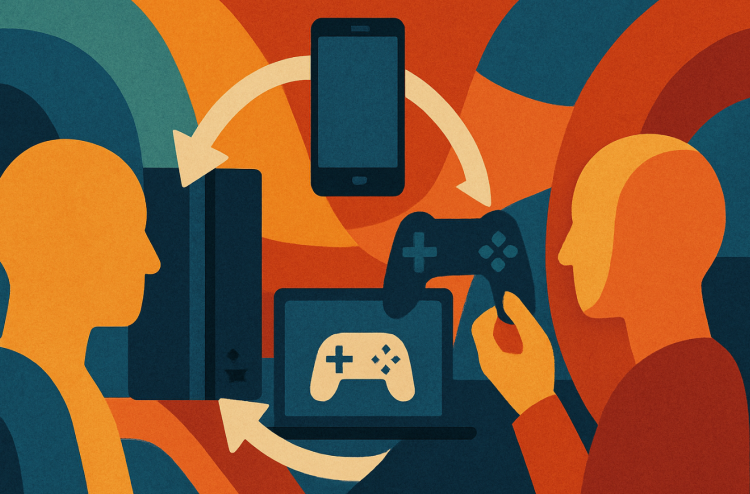The Rise of Cross-Platform Gaming: Breaking Barriers Between Players
For years, gamers have been divided by their platforms. PC players stuck to their rigs, PlayStation and Xbox users played in separate worlds, and mobile gamers were often left out entirely. But those days are rapidly disappearing. Cross-platform gaming has become one of the most revolutionary changes in the industry, breaking down barriers and uniting players across devices. In 2025, it’s no longer about what system you own — it’s about who you play with. The rise of cross-play is reshaping online gaming, creating a more connected and inclusive global community.Visit (무료슬롯) for more details.
From Isolation to Integration
In the early 2000s, multiplayer gaming was tightly controlled by console ecosystems. Sony, Microsoft, and Nintendo each built their own online networks, and none of them communicated with each other. A PlayStation user couldn’t team up with an Xbox friend, and PC gamers existed in their own separate universe. While this made sense from a business standpoint, it also fractured the gaming community. Friends were often forced to buy the same console just to play together. Over time, players started demanding more flexibility, and developers began listening. The shift toward cross-platform gaming started gradually, but once it began, it was unstoppable.
The Turning Point
The real turning point came in the late 2010s, when games like Fortnite and Rocket League introduced true cross-platform play. Epic Games took the bold step of letting players on PC, console, and mobile all share the same lobbies. It was a massive success, proving that cross-play wasn’t just possible — it was the future. Once players experienced the freedom to connect across platforms, there was no going back. Soon after, major publishers began following suit, realizing that community size and player engagement mattered far more than exclusive networks. By 2025, cross-platform functionality is no longer a novelty — it’s an expectation.
How Cross-Play Works
Cross-platform gaming relies on sophisticated networking systems that allow different hardware and software environments to communicate seamlessly. Developers use cloud-based servers and account-linked systems to ensure that player data, progress, and stats are synchronized across devices. For example, you can start a match on your PlayStation, continue it on your PC, and finish it on your mobile phone. Many modern titles now use unified login systems, such as Epic Games accounts or Microsoft’s Xbox network, to manage cross-platform profiles. The technology behind it has matured to the point where differences in frame rates or controls rarely interfere with fair competition.
Games Leading the Charge
Some of the biggest games in the world have embraced cross-play, setting new standards for the industry. Call of Duty: Warzone 3, Fortnite, Apex Legends, and Minecraft all allow players from different platforms to play together. Even traditional RPGs and sports games have joined in, with titles like Final Fantasy XIV and EA Sports FC 25 offering full cross-play integration. What makes these experiences so addictive is the freedom they provide — gamers no longer need to worry about which device their friends own. This flexibility has made multiplayer games more social and accessible than ever before.
Cross-Progression and Accessibility
Cross-platform gaming doesn’t stop at multiplayer. Cross-progression — the ability to carry your progress and purchases across devices — has become equally important. Players can now switch between platforms without losing achievements, unlocked characters, or in-game items. This level of accessibility encourages more playtime and investment in games, since players are no longer restricted by hardware limitations. It also makes gaming more inclusive, allowing families and friends to enjoy experiences together, regardless of what devices they own. The freedom to play anywhere has made gaming more portable and personal than ever.
Challenges and Balancing
Of course, the rise of cross-play hasn’t been without challenges. Balancing gameplay between different control methods — such as mouse and keyboard versus console controllers — can be tricky. Developers have had to introduce skill-based matchmaking and optional input-based lobbies to keep competition fair. Another challenge is ensuring performance consistency, since games must run smoothly across a wide range of hardware, from high-end PCs to budget smartphones. Security and cheating prevention also become more complex in cross-platform environments. Despite these hurdles, most developers agree that the benefits far outweigh the challenges.
The Business of Unity
Cross-platform gaming is not just a technical achievement; it’s also a business revolution. In the past, console makers used exclusive ecosystems to lock players into their hardware. Now, with cloud gaming and subscription models like Xbox Game Pass and NVIDIA GeForce NOW, the focus has shifted from hardware sales to player engagement. By allowing gamers to play together regardless of device, publishers can grow their audiences faster and keep them active longer. Cross-play also boosts the longevity of games, since larger, unified player bases mean faster matchmaking and healthier communities.
The Future of Cross-Platform Play
Looking ahead, cross-platform gaming is likely to expand even further. Cloud streaming services are eliminating the need for powerful consoles altogether, allowing anyone with an internet connection to play high-end titles. AI-driven matchmaking could soon tailor experiences for each player’s skill level and preferred input device, ensuring perfect balance across platforms. We may even see full integration across VR, AR, and mobile ecosystems, creating one truly unified gaming network. The lines between platforms are blurring faster than ever, and the idea of exclusivity is beginning to fade.Visit (무료슬롯) for more details.
Conclusion
Cross-platform gaming has done more than connect devices — it has connected people. By breaking down artificial barriers, it has turned the gaming world into a shared space where everyone can play together, regardless of brand or hardware. It’s a powerful reminder that gaming, at its core, is about community and creativity. In 2025, whether you’re holding a controller, using a keyboard, or tapping on a touchscreen, you’re part of one global network of players. The era of separation is over, and the future of gaming is truly universal.

